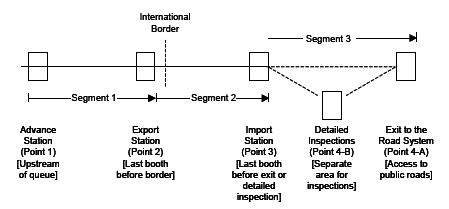Border Crossing Process
One of the first steps in developing a performance measure for international border crossings is to understand the system. The border crossing environment and procedures include a variety of operating agencies, each of them "in charge" of a certain portion of the crossing or the infrastructure. A performance measure will be successful only if it accepts and supports these often competing goals.
While there are differences in the paperwork requirements and operating procedures for freight crossing in each direction on the northern and southern borders of the U.S., the process can be described in a few common steps that are useful for defining the data collection necessary to support a national measure of freight crossing delay. Steps related to paperwork, duties and tolls are somewhat ignored in the description below. The delay from these steps is typically not a transport issue, or the transaction takes place within a queue of vehicles controlled by other steps of the process.
The crossing summary (see Figure 1) uses the term "points" to describe locations where particular actions take place. The actual point of data collection may be slightly different than the physical location of the action referred to in the description, based on the design of the individual crossing. And the points have different names—Point 3 is known as Primary Inspection in the U.S. and Canada and Primary Selection in Mexico. "Segments" refers to portions of road between the points. The segments are designed to produce information about the truck travel time and the location of delay. The "points" are not the only features in the border crossing process that can cause longer travel times, however. Specific locations, such as toll booths, might be added to the basic data collection scheme listed in this report to further investigate the contribution to delay, or the location of delay in the system.

Figure 1. Data Collection Locations and Typical Border Crossing System (Simplified Diagram)
previous | next